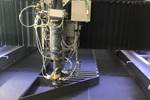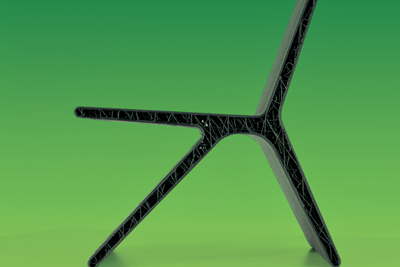Braskem, Vartega launch new carbon fiber recycling program for 3D printing filament
Carbon fiber-reinforced polypropylene (CF-PP) filament is made from 100% recycled carbon fiber to leverage recycling capabilities and plastic waste elimination.

Photo Credit: Braskem
Braskem (São Paulo, Brazil), an Americas polyolefins and biopolymers producer, announced on May 19 that it has expanded its partnership with Vartega Inc. (Golden, Colo., U.S.) a recycler of advanced materials including carbon fiber-reinforced plastics (CFRP), for a new 3D printing filament recycling program.
Per this program, Braskem expanded its 3D printing product portfolio to include carbon fiber reinforced polypropylene (CF-PP) filament for 3D printing (FL900PP-CF). This product is said to be made from 100% recycled carbon fiber supplied by Vartega and is optimized for use with Braskem’s PP. Through the new program, every box of Braskem’s CF-PP filament sold will include information about how to recycle the used carbon fiber filament. Braskem and Vartega note that 24,000 tons of carbon fiber waste is sent to a landfill every year.
“We are pleased to provide Braskem with sustainable high-performance carbon fiber for their new 3D printing filament,” says Andrew Maxey, Vartega CEO. “And by leveraging our recycling capabilities, Braskem and Vartega are able to provide an end-to-end solution for 3D printing customers. This collaboration is an excellent demonstration of what’s possible with modern supply chains and novel solutions to traditional waste problems. Landfill is not the only option, and Vartega is unlocking a captive supply of valuable materials in failed prints, support structures and filament scrap.”
According to Braskem, its CF-PP filament offers superior mechanical and thermal properties as well as low warpage and enables users to 3D print lightweight and exceptionally rigid parts for high-end applications, such as automotive, aerospace, nautical and sporting goods, just to name a few. Further, even made using 100% recycled carbon fiber, FL900PP-CF reportedly offers the same performance as virgin carbon fiber. Braskem’s CF-PP filaments are available in both 1.75- and 2.85-millimeter diameters to fit a wide range of 3D printer applications and are available for online purchase through M. Holland’s eStore.
When asked to walk CW through how this program would work, Maxey notes that “Customers of Braskem’ CF-PP 3D printing filament will send their scrap filament, failed prints and support material back to Vartega. The customer will be responsible for the shipping in the initial rollout of the program but we envision regional collection hubs with material distributors where the scrap material is consolidated. Once the scrap material is received by Vartega it will be sorted and mechanically recycled, blended and extruded to make new carbon fiber-reinforced PP pellets.”
At this point, Maxey says, the recyclate carbon fiber and PP pellets will be characterized to confirm material performance and can then be used as-is in pellet feed AM machines or made into filament again for traditional fused filament fabrication (FFF) 3D printing. “Recycled material performance will be tightly controlled via blending and analysis,” Maxey says. “Although this material will have an extra heat history, recycled PP usually retains much of its mechanical performance after recycling so we don’t expect any significant decrease in properties of the blends we’ll be creating.”
Braskem itself is committed to a carbon-neutral circular economy. For example, in 2018, Braskem committed to 100% of plastic packaging being reused, recycled or recovered by 2040. As part of its evolving sustainable development strategy, Braskem also announced additional commitments to mitigate climate change, eliminate plastic waste and provide solutions for recycled products in its markets. In addition to reaching its 2020 goal to become an Operation Clean Sweep blue member, Braskem is a founding member and funding partner of the Polypropylene Recycling Coalition. Braskem is also a founding member of the Alliance to End Plastic Waste.
“Our new filament recycling program with Vartega is part of Braskem’s broader strategy to provide solutions for recycled products and eliminate plastic waste,” notes Jason Vagnozzi, Braskem commercial director of Additive Manufacturing. “We are excited to partner with Vartega and leverage their capabilities to ensure that each spool of CF-PP is properly disposed of and does not end up in landfills. Plastic plays a vital role in society, and we believe that programs such as this will allow plastics to continue their role in advancing innovation and providing sustainable solutions.”
Does Braskem and Vartega see any potential future expansion of filament recycling programs, such as this one? “Yes, definitely,” Maxey confirmed. “With support from the Colorado Department of Public Health and Environment (CDPHE) through its Recycling Resources Economic Opportunity (RREO) competitive grant program, Vartega is making additional investments in plastic composites recycling infrastructure in Colorado. We have several projects underway where we are recycling materials from turbine blade and bicycle manufacturing, and we plan to further increase the capacity of these technologies to complement our carbon fiber recycling infrastructure.”
Related Content
Sulapac introduces Sulapac Flow 1.7 to replace PLA, ABS and PP in FDM, FGF
Available as filament and granules for extrusion, new wood composite matches properties yet is compostable, eliminates microplastics and reduces carbon footprint.
Read MoreCryo-compressed hydrogen, the best solution for storage and refueling stations?
Cryomotive’s CRYOGAS solution claims the highest storage density, lowest refueling cost and widest operating range without H2 losses while using one-fifth the carbon fiber required in compressed gas tanks.
Read MorePlant tour: Albany Engineered Composites, Rochester, N.H., U.S.
Efficient, high-quality, well-controlled composites manufacturing at volume is the mantra for this 3D weaving specialist.
Read MoreMcLaren celebrates 10 years of the McLaren P1 hybrid hypercar
Lightweight carbon fiber construction, Formula 1-inspired aerodynamics and high-performance hybrid powertrain technologies hallmark this hybrid vehicle, serve as a springboard for new race cars.
Read MoreRead Next
Cincinnati Inc. BAAM printer demonstrates 3D printing with recycled composites
Dual-material thermoplastic extrusion system produces monolithic composites tool exceeding 10 feet in length, without manual intervention.
Read MoreCovestro introduces 3D printing material made from recycled PET
Glass fiber-filled rPET suitable for high performance and structural applications using 3D pellet printing/fused granulate fabrication (FGF).
Read More“Structured air” TPS safeguards composite structures
Powered by an 85% air/15% pure polyimide aerogel, Blueshift’s novel material system protects structures during transient thermal events from -200°C to beyond 2400°C for rockets, battery boxes and more.
Read More


























